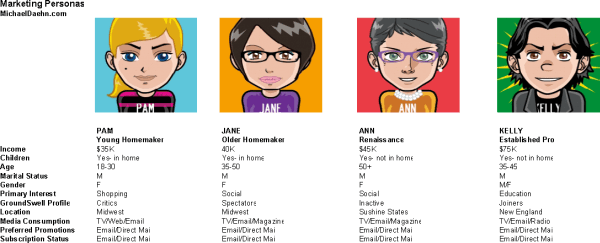
Using Your Secret Stalking Skills to Grow Your Business Through Social Media
(Some of the steps listed here are very elementary, so if you are an old pro, know that I’m trying to write to the beginner as well as the experienced)
There is a cartoon going around, maybe you have seen it, depicting Stalking in two formats – Creepy and Socially Acceptable. One stalker is using a pair of binoculars and looking into his neighbor’s yard while the second is on the computer using Facebook.

The fact is, in the business of Internet Marketing and Social Media, there is a lot of stalking done in efforts to target our marketing message or put our brand in front of the right people. Getting your demographics right and then finding those people online, who are freely putting most of their information out there for all to see, is the simplest and most affordable way to get the most leverage out of your brand and content.
While there are hundreds of articles online regarding social media best practices, this article will focus purely on social media stalking.
Stalker Step 1:
Pick a quality social monitoring tool. There are hundreds of tools on the market and all offering different value for different prices. No matter what your budget is, there will be a tool for you – the important thing is to pick one and utilize it.

The purpose of using tools is not only for the convenience of having one dashboard to look at each day for all your accounts, but also for the convenience of reporting. Monitoring your progress through reports doesn’t have to be complicated and can be as easy as a quick glance at the increase in the amount of people who followed you on Twitter or the "reach" of any particular Tweet. Reporting over time will show you what you are doing right and what you could improve.
Stalker Step 2:
Build Personas. The creation of personas is to help you define specifics around who your target audience is in a very specific way. By definition, a persona is a fictional character that is created to represent a clear picture of your market. Some people create numerous personas to represent segments of their target audience.
Many people have written about building personas. The most common advice is to name attributes of each persona to include: age, sex, ethnicity, occupation, lifestyle, goals and hobbies. There are a number of defining attributes that you can pick in building your personas. Ian Lurie wrote about Personas in 2007 and his information is still apt - http://www.portent.com/blog/internet-marketing/get_in_your_customers_heads_cr.htm

Image Credit: http://marketingenious.terapad.com/index.cfm?fa=contentNews.newsDetails&newsID=81532
Stalker Step 3:
Find Your People. Now that you have built your personas, now it is time to find your people online in their social media environment or habitat. To find your people requires the building of a map. Start off by making a list of all the keywords associated with each of your personas. Keywords can include job titles, brands they buy, hobbies, cities they live in, book titles, music, or ways they define themselves. See your persona attributes for keyword ideas.
Now, break out your keywords under topic titles. Topic titles can include your persona’s name, yes they should have a name. For example, if you are targeting a middle aged woman who has a lot of discretionary income who travels at least four times a year, who own a luxury vehicle, owns only Apple products, whose children are grown – you can call this persona “Luxury Middle Aged Women” or you can call her by her persona name.
Topic titles can also simply be the keywords themselves, such as: retired, traveler, art collector, Mercedes owner, etc.
Stalker Step 4:
Once your keyword list is complete, you are going to now build a strategy around finding the right people online and you are going to start with Twitter. While finding your people you are going to categorize them in Twitter lists, which will help you stay organized and keep everything in order.
Now, starting with your keyword list let’s start finding people. The process is actually quite simple. The first part of your Twitter search will begin with the use of SEOmoz.org’s tool Followerwonk. Within Followerwonk.com you are going to Search Twitter Bios, which is a tab at the top left portion of the page. When you click on this tab you will be taken to a search box.

After clicking on "Search Twitter Bios" a search box will open. If you click on ‘more options’ beneath that box you have the opportunity to put in more search parameters. Within the "search box" type in one of your keywords.
I typed in the term ‘art collector’ and received 1,642 results.

Each time you find somebody within your target, you will "Follow" them and add them to your Twitter list. You can build your lists as you add people. After you follow somebody, dropdown the button next to Follow and click “Add or Remove From Lists.” Then click “Create A List” and type “Art Collector”. You can then make this list private so that only you can see it. Building lists inside of Twitter helps you keep your prospects organized.

Because there can, at times, be so many people on Followerwonk to choose from, as I discovered just within the search term “art collector”, you can start with just a handful of people ranging from those with a high number of followers to those with a low number of followers. Your display will let you sort results based on Tweets, Following, Followers, Days Old, and Social Authority. Keep a nice mix within your list; following those with fewer followers could result in those people as a more likely prospect in following you back.
Next, you will use Twitter’s search function to search Tweets with keywords. For instance, if you are looking for all women who own a Mercedes, this information may not be in their bio but they may be talking about it in a Tweet. To search Tweets to go Twitter.com/search. Within the search box you can use one word or a combination of words. If you want the combination of words to show up together include parenthesis around the term. For example “Mercedes owner” will only bring up tweets with those two words mentioned together.

Stalker Step 5:
Keep track of your work using an Excel spreadsheet, aka Super Stalker Excel Spreadsheet.

Finding where your prospects are on Facebook, Google Plus, Linkedin and Pinterest will start with Twitter but doesn’t end here. You are going to need this spreadsheet as a reference as you complete the other steps.
Stalker Step 6:
After you have built out your Twitter following or at least built up a good strong list, you are going to find out where your prospects are on other social media platforms. Some people list links to their other social media accounts on their Twitter profile. If they don’t you may have to visit their website to find out this information.
In our example with Jesse Williams, the ‘art collector’ he not only shows you how to find him on Facebook and Pinterest but also what his other Twitter handles are. Most people just share their website, as with this example where “Life Coach” was searched for.

When I go to Carla Ferrer’s website I see her social media icons in the right upper-hand corner of her page – bingo. Now I know how to find her on Facebook, Pinterest and Youtube. (evil laugh here)

I will now visit each of Carla’s social media pages and either ‘Like’ her, ‘Follow’ her, add her to my Circles and so on. I will also add information about each of her pages and her website address to my Super Stalker Excel Spreadsheet.

Stalker Step 7:
After you have built out your spreadsheet, created a long healthy list of people you are following and developed your lists within Twitter, now you are going to do the following:
a. Pick out a group and begin to listen to what they are talking about. Look for things such as questions they might ask, what their interests are, who they reply to or respond to, or even what articles they promote. Make notes on what you hear within your Super Stalker Excel Spreadsheet.
When doing the above exercise, liken it to being at a social gathering and there is a group of people standing in a corner talking. If you were to join this group, you will start by listening in on the conversation before talking. Second, don’t just talk about yourself, ask questions, offer thoughtful perspective, be kind and respectful.
b. Use the information you glean to build content ideas for your blog or white papers. Strategize topics and write about them in your blog or put them into your media calendar. If you have specific knowledge about a particular area your prospect is interested in, or maybe you read an article that you feel is helpful to the prospect, share it with them.
c. Begin putting links to your blog article topics in front of your readers. Start with Twitter and follow through with each social media space – Google Plus, LinkedIn (preferably within a group you might belong to), Facebook and Pinterest. Caution: Don’t just promote yourself and your links within each post you put up, mix it up and promote other people’s work as well.
d. Retweet other people’s comments, or make a comment on something they say. Thank them for information that might be valuable. Be genuine.
Stalking is hard work and takes time. Don’t expect to create results overnight. Starting the process and maintaining it will eventually payoff and, well you never know, you might actually like it.
This YouMoz entry was submitted by one of our community members. The author’s views are entirely their own (excluding an unlikely case of hypnosis) and may not reflect the views of Moz.



Comments
Please keep your comments TAGFEE by following the community etiquette
Comments are closed. Got a burning question? Head to our Q&A section to start a new conversation.